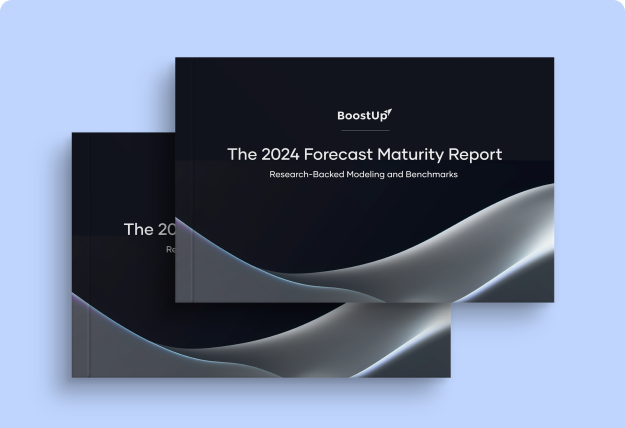The Revenue Blog /
The Forecasting Processes You Need for Extreme Accuracy
The Forecasting Processes You Need for Extreme Accuracy

Topics covered in this article
The process through which you build your sales forecast is going to be one of the largest determinators of its accuracy.
Without a well-structured, consistent, repeatable, predictable, and visible process, you cannot guarantee that the right data is being used or the correct steps are being taken.
However, you cannot mandate a process that takes too much time. Salespeople still need to sell, their managers still need to manage, and your RevOps team still has a myriad of other tasks to complete. So, you need a robust, but quick and effective forecasting process.
Want to watch the roundtable in full? View the recording or download the slides here.
Forecasting processes across different size companies
One of the most difficult aspects of sales forecasting is that no two companies are the same.
Brandon Bussey points out that a one size fits all approach will most likely lead to inconsistencies and inaccuracies within your forecast. He says that one of the largest problems in forecasting is new leaders who bring their previous forecasting approaches to new roles. Those old processes likely will not function well within the new business.
However, every forecast should have four key qualities...
1. Transparency
- The visibility goes both ways. Management needs full insight into every deal, while salespeople need to know the calls, what goes into them, and why.
- A mutual understanding allows everyone to work for the same goals.
2. Consitency
- A consistent process can make up for other areas that are lacking, as a mistake repeated over and over again is still predictable.
3. Adaptability
- The processes must be for your business, not created for another company and applied.
4. Robustness
- Brandon adds that teams should avoid a single model and that different perspectives lead to more accurate forecasts because of the angles that they provide. “Every process has different assumptions, risks, and inaccuracies, so by taking multiple approaches it really helps to triangulate your number,” he says.
- Top-down, bottom-up, data-driven, gut-driven forecasts are all more accurate when used in conjunction with one another.
How accurate does your forecast need to be?
When it comes to forecasting within your organization, it is important to think about the level of accuracy that really matters. Eric Teuscher says that the amount of accuracy required will vary by company size and stage. For example, a Series A company may only need to land within 20 or 30 percent of their forecast in order to please investors. Yet a late-stage org or public company likely needs to land within the coveted +/- 5 percent.
Forecast considerations for high-growth companies
What happens when your company growth suddenly outpaces your forecasting processes?
When it’s time to catch your processes up to your company size, you need to be mindful of your teams’ capacity, how other teams outside of sales impact the accuracy of your forecast and the taxes of a new process, says Elyse Iovino. If revenue generation is a focus - how much time do you want salespeople to now spend on forecasting? Further, how do processes such as legal, accounting, and implementation impact your forecast?
Especially in rapidly growing companies, teams must ensure that new processes are a part of onboarding so new reps are proficient in processes before they begin. Companies in hypergrowth likely have different business types with different sales cycles and inorganic growth (through acquisitions), which can both cause problems with creating a consistent forecast.
Best processes for your sales forecast
When it comes to building the most accurate sales forecasting process, there are several best practices that all experts agreed on:
Focus
- Define your key areas... Eric says to ask yourself, “What is the outcome that the process needs to create.”
- In the case of a high-growth company, Elyse says to find the biggest risk to forecast accuracy and start there.
- For other companies, Eric recommends prioritizing processes to first ensure data hygiene.
Standardization
- To maximize accuracy, you must first standardize everything.
Make sure your entire company is speaking the same language, and that definitions are upheld globally - Clearly define sales stages, how to progress between them, the functions of each role in the forecast, how they do it.
- Consistency is key. Although it’s not ideal, Brandon says that a team that is consistently inconsistent is more likely to be accurate.
Quality Data
- If you’re using the wrong numbers to make your forecast, your whole forecast will be wrong.
- Put extra effort into creating the most accurate data possible.
Deal Inspection
- Every team needs to be inspecting deals on at least a weekly basis.
- This is not only to ensure that your most important deals close, but also to guarantee forecast accuracy. Look for inconsistencies in amounts, close dates, activity levels, and any red flags that would constitute a risk in your forecast.
Involvement from Key Players
- Forecasting is a company-wide activity and therefore should involve key stakeholders from all departments.
- Don’t bring in every person though, says Brandon. Focus only on the key players and who is most impacted.
- Work with senior leaders to build processes and workflows that fit with their teams and capacities.
- Ops and IT should build the actual architecture behind a forecast, what tools and functions are necessary?
Automation
- You hired your sellers to sell and your managers to manage, not forecast. Use automation to increase their productivity and reduce forecasting workload.
- Automation removes the possibility for human error and increases data accuracy.
To view the full roundtable recording, or download the slides, go here.



-Photoroom.png)